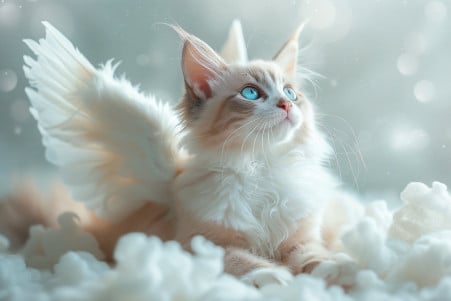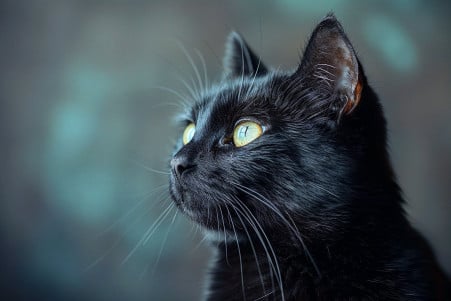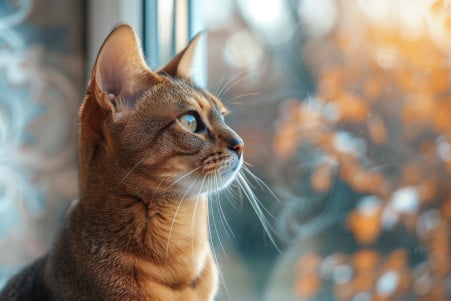Cats in the Bible: Are They Evil or Just Misunderstood?
30 May 2024 • Updated 29 May 2024

Despite the negative connotations that cats have in popular culture, the Bible and other religious texts offer a more complicated view of the animals. While the Bible never explicitly calls cats "evil," it does associate them with a number of other things that were considered negative at the time, including idolatry, paganism, and impurity.
In order to understand the biblical view of cats, we will look at a wide range of studies by religious scholars and historians that cover everything from close readings of biblical texts to archeological evidence to the cultural symbolism of cats in the ancient Near East. By taking this interdisciplinary approach, we will be able to understand the many different interpretations and meanings that have been ascribed to cats in the Bible and other sacred texts and how they have shaped the Judeo-Christian tradition.
Are cats considered evil in the Bible?
The Bible's View of Animals and Animal Welfare
The Bible also provides a clear view of the worth and welfare of animals. In Genesis 1, animals are created by God and humans are given the responsibility to care for them as stewards. This idea of stewardship suggests that humans are to treat animals with compassion rather than cruelty or abuse, a concept that is reinforced by Proverbs 12:10: "A righteous man regards the life of his animal."
While the Bible allows for the use of animals to meet human needs, including as food after the Flood, it also encourages a balanced approach. The Jewish dietary laws required that animals be killed humanely, and God's laws included the idea of conservation and the humane treatment of animals. According to Evangel Magazine, "God required the wise conservation of animals taken for food and forbade cruelty to working animals."
These general biblical principles about how animals should be treated can be used to help understand how cats, even though they aren't specifically mentioned, may have been seen in the context of a religion and culture that valued responsible stewardship over exploitation.
Cats in the Ancient Near East: Cultural Symbolism and Religious Significance
Cats were revered in ancient Egyptian society, where they were frequently depicted in art and associated with the divine and protection. As the World History Encyclopedia explains, the goddess Bastet, who was often shown as a lioness or a woman with a lioness's head, was one of the most popular deities in the Egyptian pantheon. Bastet was the goddess of the home and domesticity, the protector of women's secrets, the defender against evil spirits and disease, and the goddess of cats.
On the other hand, cats were mostly absent from Israelite literature, which indicates a different cultural perspective on the animals. This may have been due to the Israelites' rejection of the Egyptian worship of cats or the influence of Persian beliefs that saw cats as vermin, according to HISTORY. While archaeological evidence shows that cats were present in ancient Israel, their numbers and prominence were likely limited by cultural attitudes.
Recognizing the different symbolic and religious roles of cats throughout the ancient Near East can help explain why cats were, or were not, mentioned in the Bible. This more complex understanding can also help explain how cats may have been seen within the Judeo-Christian tradition even when they were not directly mentioned.
Symbolic and Metaphorical Depictions of Cats in the Bible
Although cats are never mentioned by name in the Bible, there are several possible references to cat-like creatures or symbolic associations. In the Book of Baruch, an apocryphal book of the Bible, cats are linked to pagan deities, which may have been influenced by their role in Babylonian religion or Egyptian cultic practices. This passage describes cats as sitting with "impunity on the images of the heathen gods, showing their complete indifference toward and perhaps even disdain for these idols created by men."
Outside of the Bible, Jewish folklore and legends, such as The Quarrel of the Cat and Dog, provide examples of how cats were viewed in the cultural imagination. These tales demonstrate the sometimes adversarial relationship between cats and other animals, as well as the symbolic meaning of cats.
The broader context of animals as symbols and metaphors in the Bible can also help to illuminate the possible symbolic role of cats. According to Aish.com, the Talmud and other Jewish texts have used cats as a basis for lessons about modesty and hunting. This indicates that, even in the absence of direct references, cats may have had a symbolic role in Jewish and Christian religious traditions.
From Ancient Egypt to the Middle Ages: How Christian Views of Cats Have Changed Over Time
During the Middle Ages, cats were largely reviled by the Christian church and were associated with evil, Satan, and heretical sects. According to Medievalists.net, "Cats in medieval Europe mostly had a bad reputation – they were associated with witches and heretics, and it was believed that the devil could transform himself into a black cat." This negative characterization of cats stood in stark contrast to their revered status in ancient Egypt and other ancient cultures.
The church's persecution of cats became even more pronounced after Pope Gregory IX issued the bull Vox in Rama in 1233, which, as the World History Encyclopedia observes, "denounced cats – especially black cats – as evil and in league with Satan." This led to the association of cats with witchcraft and the occult and the subsequent mass killing of cats.
However, despite this negative view, cats were eventually accepted back into the home during the Reformation and Enlightenment. As the World History Encyclopedia notes, "The Protestant Reformation (1517-1648) broke the power-hold of the Church over people's lives and allowed for greater freedom of thought. The spirit of the Enlightenment encouraged people to keep cats as pets simply for the joy of companionship and this trend would become more commonplace during the Victorian Age (1837-1901) when Queen Victoria returned the cat to the status it had enjoyed in ancient Egypt."
This history of Christian attitudes toward cats, from their demonization in the Middle Ages to their eventual rehabilitation, is an important backdrop for understanding how cats are depicted in the Bible and other religious texts.
Conclusion: Reexamining the Portrayal of Cats in Biblical Texts
The Bible never mentions cats by name, but the way they are depicted is still complex and shaped by cultural and religious factors. The lack of explicit references to cats doesn’t necessarily mean they were viewed negatively, but instead reflects the historical and symbolic roles cats played in the ancient Near East. The Bible’s teachings about treating animals with kindness and compassion would seem to apply to cats, even if they are never singled out.
Recognizing the different ways cats have been viewed in different societies and historical periods can help us better understand their portrayal in religious texts. This article has sought to illuminate the multifaceted and sometimes contradictory ways cats are depicted in the Bible and other religious texts.


